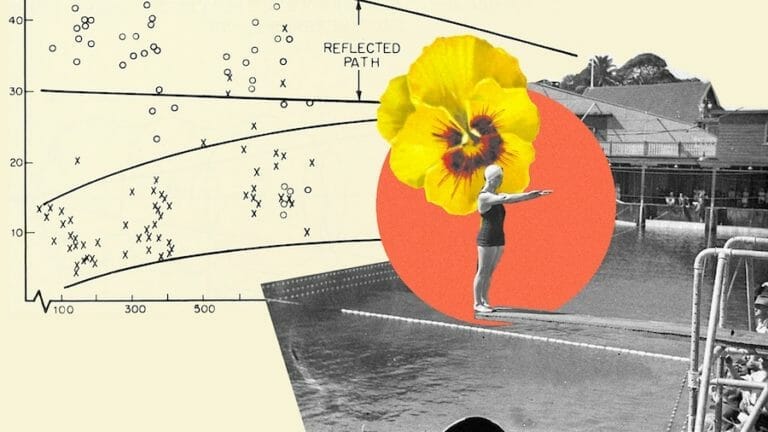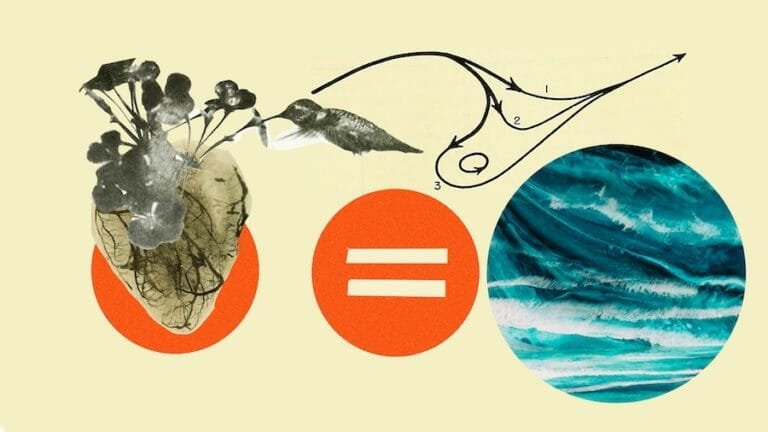The Triadic Heart of Siva, the Kaula Tantricism of Abhinavagupta, discusses the concept of vibrations and how they are related to the Heart—and how we can utilize these functions of the Heart to achieve Brahman, or “the Ultimate Consciousness.” The Triadic Heart of Siva compares the Heart to that of an infinite ocean with finite, polarizing waves of consciousness, shedding light on how we can “catch a wave” to discover the omnipotence and bliss of our inner selves, guiding us on our return to Siva.

Spanda or “slight movement”
In Sanskrit, spanda loosely translates to “slight movement” and refers to the vibrations and pulses of the universe, which are able to manifest itself as vibrations that are present throughout the living world and within ourselves–in the Heart. In this section of chapter of 6, Abhinavagupta stresses the importance of what is called “self-referral,” or vimarsa, which is deemed to be an “essential characteristic of consciousness.”
Self-referral allows us to double back: on our consciousness, allowing us to connect with our inner selves. This recognition of self-consciousness is what creates spanda within us—a vibration that resonates within the Heart and brings us closer to achieving the Ultimate Consciousness. Spanda also happens to be something of an umbrella term, under which the words sphurana, sphurita, and sphuratta all reside under. With the prefix sphur-, relating to the “throbbing” or “quivering” of an object, these words are used in The Triadic Heart of Siva to richly describe these vibrations that surround us and that are within us.
Spanda and Shakti
We know that spanda refers to the vibrations that give rise to our consciousness, but those very vibrations have their roots, too. This is where shakti is introduced. In Hinduism, Shakti is the name of the divine cosmic energy, representative of the dynamic forces that flow throughout our universe. These are characterized by waves caused by disturbances and agitations (ksobha and ghurnana, respectively), and are responsible for the vibrations that allow us to have our consciousness—therefore creating the foundation for reality. These waves are also described by Abhinavagupta to be akin to contractions, or an opening and closing motion—not unlike the very motions of our physical heart!

Non-dualism is then promptly introduced. Spiritually, nondualism refers to the idea that everything in the universe is derived, and therefore connected to, the Ultimate, Eternal Spirit, or Brahman—also commonly known as “oneness.” Basically, though it may seem that our universe is made up of multiple layers and spectrums, they all have the same underlying foundation, characterized in The Triadic Heart of Siva by a pendulum, swinging back and forth throughout the universe without surrendering this concept of nondualism. Being aware of these concepts is the first step to truly understanding the Heart.
Ultimately, spanda is like the muscles to the Heart, bringing it to life with contractions, and by expanding and receding within itself. It operates akin to a seesaw; where on one end sits knowledge, and the other ignorance, enjoyment and liberation.
Knowing that the Heart contracts and expands, we can dive into what these notions mean. According to Abhinhavagupta, the contraction of the Heart denotes that the spirit is in a state of ignorance, and refuses to see and reach towards enlightenment. However, all contractions must eventually cease, and, when they do, the Self can present itself, allowing us to return to Brahman and be one with the Ultimate Spirit. This action of expanding and contrasting is one of the major characteristics of the Heart, as it seeks to achieve non-duality.
Visarga: Emissional Power
Abhinavagupta defines visarga to be another vital component to the Heart, translating to “Emissonal Power.” Visarga is also dubbed the most “tantric” in the mind of Abhinavagupta, for it is such an important notion. In Sanskrit phonology, visarga is also the term coined for pure aspiration—a simple word with extreme meaning behind it.
The power that visarga holds can be described as that of an impelling force: one that simultaneously thrusts everything out into the world, while also absorbing it back into Siva. It absorbs and unifies in the same breath. These motions create somewhat of an “alternating current” that yogin—those who practice yoga—can tap into and utilize, either to manifest desires and experience non-duality (expansion), or to become in touch with their original consciousness. Because these vibrations are infinitely fast, one can reach the state of Bhairava—otherwise known as a state of fearlessness and liberation.

Essentially, visarga is the capacity of consciousness, and the highest power of consciousness is freedom. Because of how it contracts and expands, it is able to manifest multiple realities from Siva. These manifestations technically do not ever emerge from the Ultimate; rather, they exist within the Ultimate. The finite envelopes the infinite. Within the deepest parts of the Heart, then, exists the Ultimate reality. This Ultimate reality is never motionless—it is constantly moving, throbbing within the Heart, to create reality as we know it, on multiple levels.
If we are to reach this infinite consciousness, we must be willing to go with the flow of visarga. Knowing how it is ever expanding and contracting, we can essentially ride its vibrations like waves, into the vast ocean that represents consciousness. Doing this allows us to transform our finite awareness into that of the Heart’s infinite awareness, bringing us to the next chapter of The Triadic Heart of Siva.
Ocean and Wave
As mentioned above, the Heart is made akin to an ocean, where countless waves of consciousness flow throughout. These waves are constant—even if the oceans we know are sometimes still and without them. The spanda is what fuels the surface of the ocean of consciousness, with constant activity and patterns. The ocean and its waves are very similar to one another, except that the ocean is infinite, and its waves are finite.

The Triadic Heart of Siva goes on to quote a passage from the Rg Veda, which says, “Seers seeking in their heart with wisdom found the bond of existence in non-existence.” This small passage sheds light on just how vital of a role the Heart plays in seeking out and reaching the Ultimate consciousness. Existence and non-existence are linked within the Heart. To put it simply, it is as if the Heart is an ocean, with consciousness flowing continuously in waves, and the words we speak form rivers, which connect us to the Heart.
And while the term “Heart” has been coined to equate to the Ultimate consciousness, that is not to say that it is related to our anatomical heart; rather, it has been translated to refer to a number of things, from the “middle” or “center” of something, to the “bowels.” Hrd and hrdaya are also terms that translated to the Heart in Vedic scripts, and were cited many times in the Rg Veda. Jan Gonda, a Dutch indologist, states that “the heart is the organ with which one is able to see what is denied to the physical eye” and “it is the heart which enables a human being to penetrate into deep secrets and mysteries.”
These two quotes highlight the importance of becoming in tune with Brahman and the Heart: once one is able to tap in to the Ultimate consciousness, they will be able to return to Shiva, achieving liberation and pure bliss.
